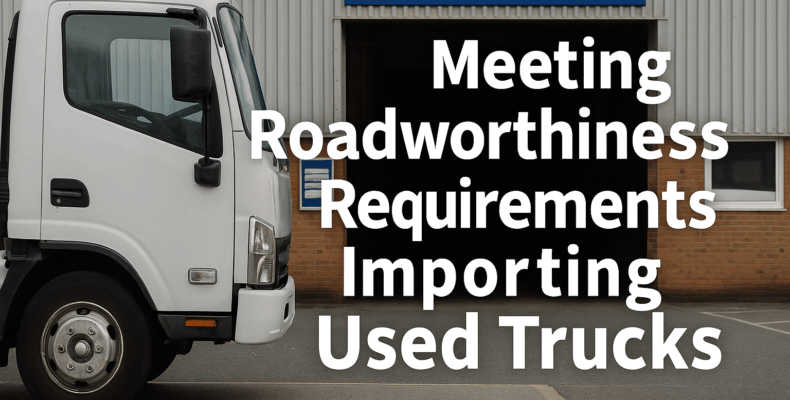When you import a Japanese used truck, the journey doesn’t end at customs. To legally drive your truck, you must first pass a roadworthiness inspection in your country. This step ensures your truck is safe, clean, and compliant with local regulations.
Fortunately, Japanese trucks—like Isuzu Elf, Hino Dutro, and Mitsubishi Fuso Canter—are well-built and usually maintained to a high standard. Still, even the best trucks need to meet local road laws, which can vary from one country to another.
This guide will help you prepare your imported truck for inspection, avoid delays, and drive confidently on foreign roads.
🚚 Why Roadworthiness Matters
Every country has rules to keep unsafe vehicles off public roads. These roadworthiness checks test for:
-
Mechanical safety
-
Emission control
-
Structural integrity
-
Functioning lights and brakes
-
Correct steering and suspension systems
Failing the inspection means you can’t register or insure the truck. Even worse, your truck could be rejected at customs.
🧾 Typical Roadworthiness Checklist
Although exact requirements vary, most inspection centers check the following:
✅ Braking System
-
Pads, rotors, and fluid levels
-
Emergency brake function
-
Even brake force across axles
✅ Lights and Signals
-
Headlights, tail lights, indicators, and reverse lights
-
Brake lights must work with both pedal and emergency systems
-
Clean lens covers with no cracks
✅ Tires and Wheels
-
Minimum tread depth (often 1.6mm or higher)
-
No cracks, bulges, or excessive wear
-
Wheels aligned and free of damage
✅ Steering and Suspension
-
No loose joints or abnormal play
-
Shocks and springs in good condition
-
Steering response must be precise
✅ Emissions and Engine
-
No visible smoke from exhaust
-
Engine should idle smoothly
-
Must pass local emissions limits or testing machines
✅ Chassis and Frame
-
No structural rust or weld repairs in critical areas
-
VIN must be readable
-
Frame must be straight with no impact signs
🌍 Country-Specific Roadworthiness Rules
🇰🇪 Kenya
-
Must pass KEBS or QISJ inspection before leaving Japan
-
Local inspection done by NTSA upon arrival
-
Emission compliance to Euro 4 standards required
🇺🇬 Uganda
-
Must meet UNBS roadworthiness guidelines
-
Age and mileage limits apply
-
Retesting required every two years
🇳🇿 New Zealand
-
Requires Entry Certification before registration
-
In-depth mechanical inspection by certified testers
-
Emission and noise testing part of approval process
🇦🇪 UAE
-
Inspection done at RTA centers
-
Trucks must meet GCC specifications
-
Focus on safety, emissions, and visibility features
🛠️ How to Prepare Your Truck
Before sending the truck for inspection, take these steps:
-
Replace worn brake pads and tires
-
Check all bulbs and lights
-
Clean engine bay and undercarriage
-
Fix fluid leaks
-
Inspect belts and hoses
-
Adjust steering alignment
You can also ask your exporter for pre-export inspection or reconditioning. Many Japanese exporters offer this service.
🏢 Choose a Trusted Exporter for Peace of Mind
Not all exporters prepare trucks for overseas road standards. That’s why it’s smart to buy from reputable professionals who offer roadworthy units and support.
👉 Check this helpful list:
Top 5 Trusted Japanese Used Truck Exporters for Global Buyers
They know your country’s inspection rules and can recommend suitable models.
📝 Final Thoughts
Passing your country’s roadworthiness test is a crucial step to getting your Japanese truck on the road. However, with the right preparation, paperwork, and a reliable exporter, the process can be quick and stress-free.
Don’t skip safety. Always verify your truck’s mechanical condition and local compliance needs before registration. After all, a well-maintained truck isn’t just legal—it’s safe, efficient, and built to last.
